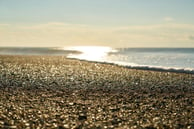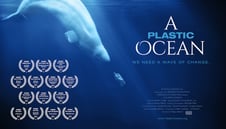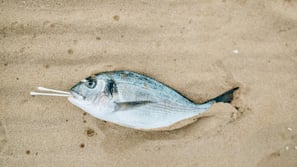The Hidden Danger of Micro-plastics
How They Impact Our Oceans, Marine Life, and You


The Beautiful Illusion of Clean Seas: The Growing Problem of Micro-plastic Pollution
Have you ever learned something new about something you’ve known your whole life, and it completely changed the way you see it? It’s like once you know that piece of information, you just can’t unsee it. Every time you think about it, your mind automatically goes back to that new image or thought. That’s exactly how I felt after watching A Plastic Ocean. It got me thinking… what are we really eating when we eat fish? Are we eating the natural marine animals of our ecosystem? Or are we eating some mutated version? Or, maybe, we’re just eating plastic?


What Are Microplastics and Why Are They a Problem?
It’s my turn to paint a picture in your mind. :) Have you ever seen a ‘glitter beach’? A beach that shimmers in the sunlight? It’s this stunning, colorful view—only to realize that it’s full of plastic mixed with the sand. And we’re not talking about those glowing, bioluminescent beaches—this is just plastic, everywhere. But you might wonder, why is it ‘mixed with sand’ or ‘glitter’ and still ‘beautiful’? Well, to be exact, we’re talking about micro-plastics. These tiny bits of plastic are less than 5mm in size. They can come from raw materials used in plastic manufacturing or from the breakdown of larger plastic waste floating in the ocean, slowly degrading over time.


How Microplastics End Up in the Ocean and Impact Marine Life
Now that we know what micro-plastics are, why is it so scary to see that ‘glitter beach’ I mentioned? Aside from the fact that it’s essentially a mix of sand and pieces of waste that have been degraded over time by the sun, wind, and saltwater, let me paint a second picture for you. Imagine that beautiful sea we all love—clear water, perfect weather, and a cool breeze running through your hair. When you're out there, it feels like you’re escaping the toxic world around you. But this time, you’re actually facing all that ‘toxicity.’ The ocean is filled with micro-plastics that we simply can’t see. With so many of them in the water, we’re likely swimming in micro-plastics every time we jump in. So, if you’ve ever swallowed a mouthful of seawater, just think about how much micro-plastic you’ve just ingested. Now, here are some facts to consider:
8 million tons of plastic enter the ocean every year, with a significant portion breaking down into micro-plastics over time (National Geographic).
In some regions, there are up to 1.3 million pieces of micro-plastic in just one square kilometer of ocean surface (Marine Pollution Bulletin, 2015).
Up to 12,000 tons of micro-plastics may wash up on beaches worldwide every year (Science Advances, 2020).
Studies show that nearly one-third of fish and shellfish sampled around the world contain micro-plastics (Science Advances, 2019).
The Shocking Truth: How Microplastics Are Entering Our Food Chain
When you see these staggering numbers, it becomes clearer how micro-plastics are filling our oceans. But what does that really mean for us? After all, we don’t just go around swallowing seawater for fun. But the fish and seabirds around the world aren’t as picky. They mistake these tiny particles for food and start feasting on them. Eventually, they end up filling their stomachs with micro-plastics, making them sick or disrupting their diets. You might think it’s bad enough for turtles to mistake plastic bags for jellyfish, or for whales to gulp down all kinds of plastic waste, or even dolphins getting tangled in fishing nets. But it’s not just the big guys—small fish, plankton, corals, and shellfish are all consuming micro-plastics too. And they’re passing it up the food chain, eventually making their way to our plates. And let’s not forget—micro-plastics also absorb harmful pollutants like pesticides and heavy metals. This means that the fish, birds, and corals are not just contaminated by plastic—they’re sickened by toxic chemicals. So, without even realizing it, while bigger fish eat the smaller fish, and we eat the bigger fish, we’re essentially consuming fish that are ‘infected’ with micro-plastics and pollutants. The very same plastic waste we’ve been hoping to just toss into the deep blue ocean.
So just think about this cycle… The never-ending loop of using single-use plastics, throwing them away without a second thought, and never really knowing where they end up. Maybe our plastic waste drifts across the world, while theirs washes up near our shores. The truth is, seafood is something many of us love—if we don’t overfish and actually take care of the ocean, it’s a resource we should all be able to enjoy.
But maybe you’re thinking, ‘I’ll just stop eating seafood, and that’ll solve the problem.’ Unfortunately, it’s not that simple. Skipping seafood doesn’t mean you’re free from micro-plastics. Because the reality is—it might already be too late. Microplastics have been found in both tap and bottled water worldwide. They’re so small that most water treatment plants can’t filter them out, and they may even come straight from the bottling process itself. The unsettling truth? There’s no way for us to know if these tiny plastic particles are already in our bodies.
At this point, the best thing we can do is try to limit the amount of plastic entering the ocean each year and work towards slowly reducing the micro-plastics already out there. It won’t be an overnight fix, but every effort counts.
Small Actions, Big Impact: How You Can Help Reduce Micro-plastic Pollution
With that said, are there more practical ways for us to reduce ‘micro-plastic pollution’? Luckily, there are a few things we can do to target this issue directly. Of course, the first step is always within our own hands—reducing single-use plastics. Opting for reusable water bottles, bags, containers, and utensils can make a huge difference. But here's something to consider: many micro-plastics weren’t originally designed to be that small. They were once larger plastic items that eventually broke down into these tiny pieces. So, the second thing we can do is get involved in beach clean-ups—removing plastic waste before it has the chance to break down into micro-plastics. Lastly, we need to raise awareness. Advocate for the dangers of micro-plastics, educate others, and push for stricter plastic policies to help prevent further damage.
As for personal care items, it’s important to be mindful of products containing polyethylene or polypropylene—plastics commonly found in skincare products, clothing, and even toothpaste. While we can't entirely control the micro-plastic release from synthetic fabrics, we can make a difference by using microfiber-catching laundry bags like the Guppyfriend. It’s the little actions like these that, collectively, add up and contribute to a cleaner world.
The Global Crisis of Micro-plastic Pollution and How You Can Make a Difference
Micro-plastics are a hidden but pervasive problem, showing up in our oceans, marine life, and even our food. While the scale of the issue may feel overwhelming, it’s important to remember that small, consistent actions add up over time. By reducing our single-use plastic consumption, participating in clean-up efforts, and making more mindful choices in our daily lives, we can contribute to a cleaner, healthier planet.
So, what's one change you can make today to help reduce micro-plastic pollution? Whether it’s swapping out a plastic bottle for a reusable one, supporting sustainable brands, or even simply spreading awareness—every little effort counts. The choice is yours.






Explore
Celebrate coastal artistry and embrace the journey toward sustainable living
Crafted
CONTACT US
© 2025 Current Journeys. All Rights Reserved. The designs, images, and content on this website are the exclusive property of Current Journeys and may not be reproduced or used without written permission.
Return & Refund Policy
Inspired
